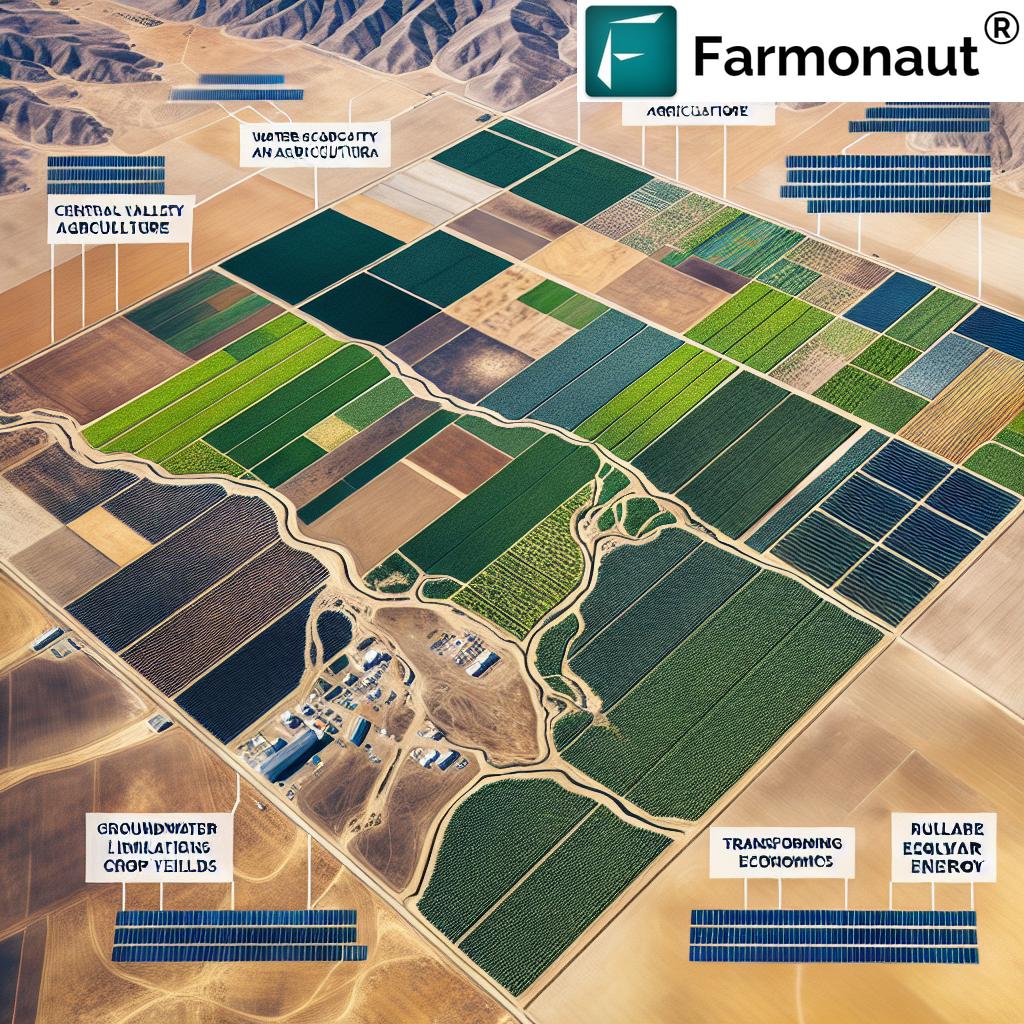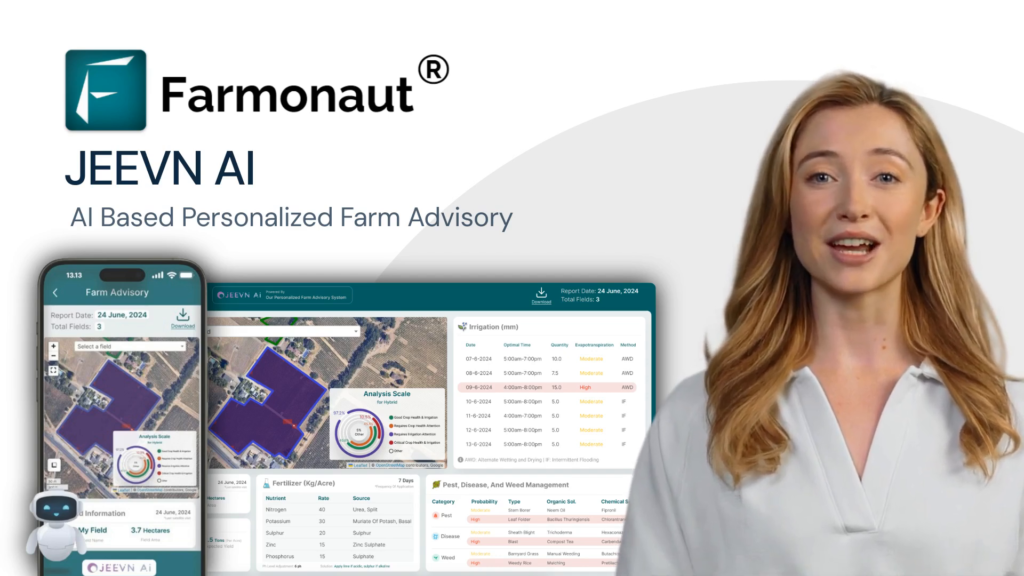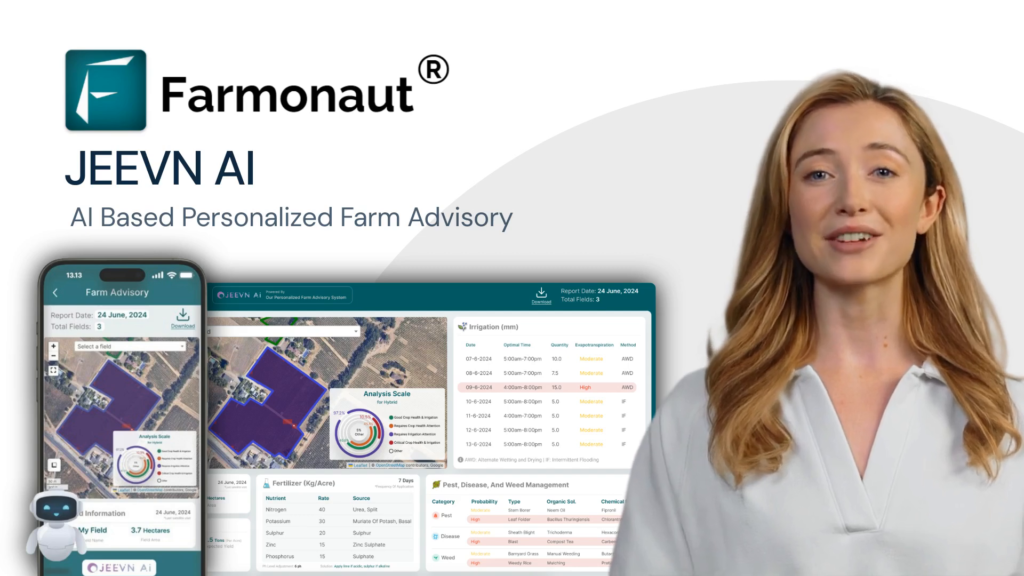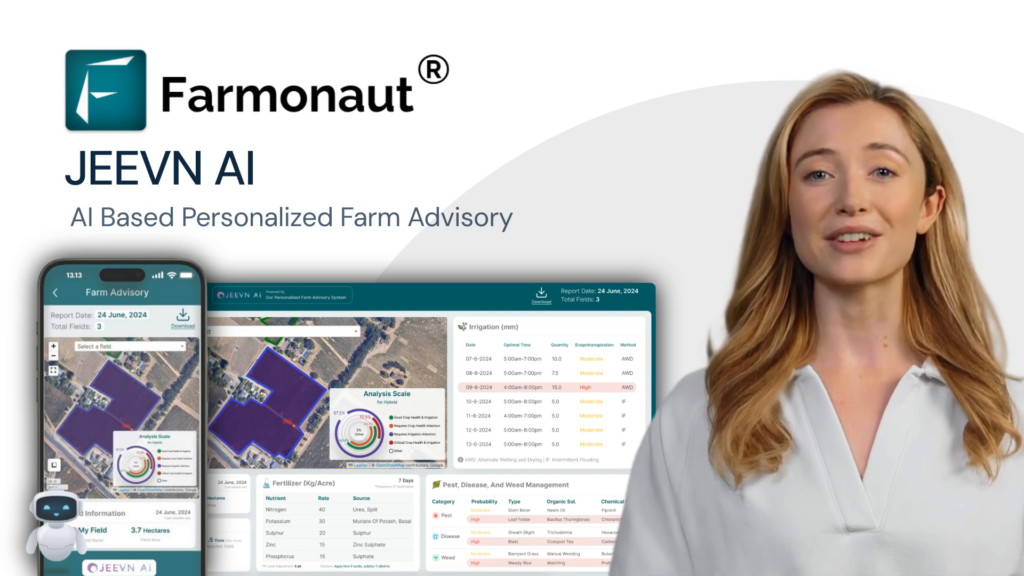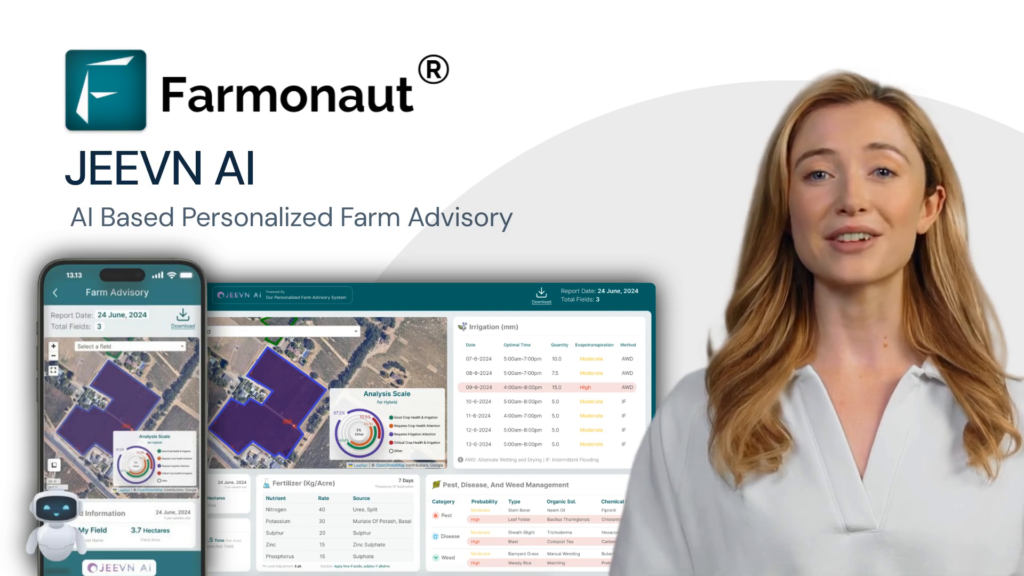Solar Energy for Farmers: 7 Powerful Benefits for Kern County Ag Land
Table of Contents
- Introduction: Clean Energy Solutions for Kern County
- AB 1156: Transforming Central Valley Ag Land
- The 7 Powerful Benefits: Solar Energy for Farmers
- Comparative Benefits Table
- How Farmonaut Enhances Agricultural Resilience
- Guide: Leasing Farmland for Solar Power
- FAQs: Solar for Kern County Agriculture
- Get Started with Farmonaut & Solar Solutions
“Kern County farmers adopting solar energy can reduce annual energy costs by up to 70%, boosting farm profitability.”
Introduction: Clean Energy Solutions for Kern County
In recent years, solar energy for farmers has rapidly evolved from a niche interest into a vital strategy for restoring revenue, conserving water, and enhancing rural resilience—especially in regions like Kern County, California. As the agricultural landscape faces the dual pressures of water scarcity and rising energy costs, clean energy projects are no longer just environmentally commendable—they’re essential for ag sustainability and profitability. With new legislation such as AB 1156 in motion, the future of agriculture in the Central Valley is entering an unprecedented era where farming and renewable energy production thrive side by side.
AB 1156: Transforming Central Valley Ag Land
The legislative landscape is changing rapidly for California farmers. Assembly Bill 1156 (AB 1156) is set to be a game-changer, especially for Kern County and surrounding Central Valley counties that serve as the backbone of US agriculture but are increasingly challenged by water scarcity and groundwater limitations under the Sustainable Groundwater Management Act (SGMA).
Here’s what AB 1156 brings to the table:
- Streamlines regulatory hurdles for landowners to lease portions of farmland for solar panel installations and renewable energy projects.
- Allows leasing farmland for solar power on fallowed or barren areas, restoring lost revenue due to groundwater rules.
- Participation is completely voluntary for both farmers and local counties.
- Fair, flexible leases: Lease agreements (usually 20-30 years) with a guaranteed option to reclaim production land if water returns.
This initiative not only supports agricultural resilience but also aligns farms with the state’s renewable energy goals, turning ground previously left idle into productive assets that benefit communities, farms, and the grid.
The 7 Powerful Benefits: Solar Energy for Farmers in Kern County
Let’s explore the 7 key advantages of solar energy for farmers in Kern County, focusing on how they address common issues, offer financial relief, and build a sustainable agricultural ecosystem.
1. Revenue Restoration on Fallowed Ag Land
Water scarcity in California agriculture continues to push significant portions of Kern County farmland out of active production, leaving valuable land barren. By converting agricultural land to renewable energy sites, farmers can transform liabilities into reliable revenue streams. Solar projects pay attractive lease payments—often more stable and predictable than crop yields impacted by groundwater limitations.
- Solar leases can generate $400–$1,200 per acre annually for underutilized land.
- This income helps cover ongoing farm costs during drought or market downturns.
- It sustains local jobs and tax revenues for communities.
2. Water Use Efficiency and Drought Resilience
Solar installations on fallowed ground mean farms aren’t draining limited water resources. Instead, solar energy for farmers allows us to rest the groundwater—critical under SGMA—and focus our remaining water on the most productive crop areas.
Solar-powered irrigation (where irrigation continues) improves efficiency even further, using just-in-time pumping and smart grid management to deliver water exactly when and where it’s needed.
- Solar-powered pumps can reduce energy costs for irrigation by 40–65%.
- Paired with precision ag tools (like soil moisture sensors), farms can cut water use by up to 30%.
“Solar-powered irrigation systems can save up to 30% more water compared to traditional methods, enhancing drought resilience.”
3. Energy Cost Reduction & Grid Modernization
Electricity demand in California is going up fast—projected to rise 80% by 2045. Utility bills are skyrocketing, especially for us on agricultural land. Solar panel installations on farmland help offset or replace imported grid power, slashing operational costs. For larger facilities, hosting solar power plants not only yields lease revenue, but also allows us to negotiate lower-cost direct power purchase agreements (PPAs) for future ag operations.
- Farmers can often save 50–70% on annual electricity costs
- Less exposure to rate hikes, power outages, and grid instability
4. Boosting Local Jobs and Rural Resilience
Bringing in outside investment for solar energy projects on Kern County ag land has a strong multiplier effect in rural communities:
- Temporary and permanent jobs (construction, maintenance, electrical, site monitoring)
- Stimulates local businesses and service sectors
- Helps us “revive” areas hit hardest by drought and fallowing, supporting community issue resolution
5. Land Stewardship and Flexible Use
Leasing farm land for solar is not a permanent conversion. Under AB 1156, after a typical 20–30 year lease, the land may be reclaimed for agriculture if groundwater improves. Additionally, these solar panel installations on farmland:
- Can be removed cleanly, with minimal soil impact
- Preserve prime ag soils for future food production
- Allow for co-location (agrivoltaics): merging crop or grazing with solar energy production where feasible
This flexible stewardship model allows us to adapt to market and climate realities, maximizing long-term farm value.
6. Advancing Clean Energy and Climate Goals
Every acre of solar panel installations on farmland supports California’s aggressive renewable clean energy targets. Farmers in Kern County and the broader Central Valley play a central role in:
- Reducing carbon emissions from power production
- Replacing fossil fuel generation with renewables
- Enhancing climate resilience in the ag sector
If you’re committed to a sustainable ag future, explore Farmonaut’s Carbon Footprinting solution—it lets you track and optimize your farm’s greenhouse gas impact using real-time satellite data.
7. Overcoming Financial Barriers to Solar Adoption in Agriculture
Upfront costs and complex permitting have long held back solar and wind projects in agriculture. With AB 1156 cutting through regulatory hurdles and financial barriers, major hurdles are being dismantled for us:
- Low- or no-cost entry for landowners through third-party leases
- State and federal grants, incentives, and low-interest loans
- Turn-key developers handle planning, permitting, investing, and maintenance
By hosting a solar power plant on your farm, you gain reliable income, spur community benefits, and future-proof your operation—all with minimal up-front investment.
Comparative Benefits Table: Solar Energy for Farmers in Kern County
| Benefit | Description | Estimated Impact | Relevance to Kern County |
|---|---|---|---|
| Revenue Restoration | Leasing fallowed land for clean energy restores predictable revenue streams for farmers. | $400–$1,200/acre/year in lease income | Major boost for farms impacted by groundwater/surface water cuts & fallowing |
| Water Use Efficiency | Solar-powered irrigation and rested land reduce total water draw from aquifers. | Up to 30% water savings (irrigation), 100% savings (fallowed) | Directly targets regions with severe SGMA and drought stress |
| Energy Cost Reduction | On-site generation/hybrid leasing lowers farm utility expenses and stabilizes costs. | 50–70% electricity bill savings; lower volatility | High-value as energy costs surge in California’s ag sector |
| Job & Economy Growth | Solar development creates local jobs, strengthens service sector, revives communities. | 10–20+ jobs per MW; boost to rural services | Vital for high-unemployment and drought-impacted rural areas |
| Land Stewardship | Opportunities for restoration post-lease, co-location, and soil preservation. | Qualifies land for future ag use or conservation | Preserves prime ag soils and land value |
| Clean Energy & Climate Action | Solar projects reduce carbon emissions and contribute to state renewable targets. | ~1,400 tons CO2 offset per MW annually | Kern County hosts both top-tier ag land and clean energy sites |
| Barrier Reduction | AB 1156 streamlines regulatory/financial processes, aiding wide adoption. | Cut 30%+ in time/cost of permitting | Crucial for accelerating energy project deployment at scale |
Did you know Farmonaut delivers advanced, satellite-powered crop health monitoring and resource management solutions for Kern County farms? Our platform lets you:
- Track real-time vegetation indices (NDVI), soil moisture, and stress events for smarter irrigation
- Predict crop yields and optimize input, even as climate conditions fluctuate
This empowers us to get the most out of every irrigated acre, saving both water and money!
Satellite Data as a Solution for Water Scarcity and Crop Yields
In the age of water scarcity in California agriculture, precision tools are a must. Farmonaut’s Jeevn AI Advisory System makes managing crops under groundwater limitations and crop yields much easier. Jeevn AI combines real-time weather, satellite imagery, and field data to generate bespoke irrigation and management plans:
- Pinpoints stress before it becomes visible
- Helps decide which crop areas to prioritize when groundwater is restricted
- Improves fertilizer and pest management timing to maximize yields and minimize waste
Explore Farmonaut’s app to unlock these benefits.
Blockchain Traceability and Carbon Footprinting for Agriculture
Demand for traceable, low-carbon ag products is surging. With Farmonaut’s blockchain-based traceability, you can verify the entire journey of your crops—enhancing food safety and brand trust. And for progressive farms aligning with carbon-smart markets, Farmonaut’s Carbon Footprinting tools provide real-time emissions data to:
- Quantify your carbon savings from solar, electric, and resource-efficient farming
- Support eligibility for climate finance or premium markets
Small and large ag businesses can further optimize logistics and reduce costs with Farmonaut’s Fleet Management tools—track every vehicle or implement across vast Central Valley operations, supporting both precision farming and post-harvest logistics. For plantations needing end-to-end oversight at scale, explore our Large Scale Farm Management suite.
How Farmonaut Solutions Complement Solar Energy for Farmers
Here’s how Farmonaut’s technologies position your Kern County ag business to benefit from the renewable energy transition:
- Satellite-Based Monitoring: Monitors field health, soil moisture, and irrigation efficiency—reducing water and input risks even on split-use (solar/ag) land.
- AI Advisory & Jeevn: Custom irrigation and management, ensuring every irrigated acre remains profitable and drought-resistant.
- Blockchain Traceability: Unlocks carbon credits and supply chain trust—vital for farms with clean energy profiles.
- Carbon Footprinting: Quantifies and maximizes your GHG savings from solar project adoption.
- Fleet & Resource Management: Lower operational emissions, maximize resource flow between energy/food production areas.
Whether you’re focused on revitalizing fallowed land or want to build climate-smart, profitable ag operations, Farmonaut helps us lead the way in smart, sustainable food and power production.
How to Lease Farmland for Solar Power: Step-By-Step Guide
Are you intrigued by leasing farmland for solar power but unsure of the process? Here’s a quick primer designed for ag landowners in Kern County and the Central Valley:
-
Assess Land Suitability:
- Identify fallowed or low-yielding ground (flat, well-drained, close to grid connections).
- Quantify your eligible acreage for potential conversion.
-
Contact Solar Developers:
- Many firms evaluate sites at no cost and model lease scenarios for you.
-
Navigate Regulations:
- AB 1156 reduces local permitting complexity and timeframes for counties and landowners.
-
Negotiate Lease Terms:
- Typical leases run 20–30 years with annual escalators and clear reclamation clauses.
-
Install & Connect:
- Developers handle panel installations, permits, grid hookups, and ongoing operations & maintenance.
-
Monitor & Report ROI:
- Use Farmonaut for ongoing satellite monitoring to track both ag and solar site impacts.
By integrating clean energy solutions and precision ag technology, farmers and landowners can maximize all available resources—making the land work for us, whether in food or power production.
FAQs: Solar Energy for Farmers in Kern County
-
Q: Is solar leasing a permanent loss of agricultural land in Kern County?
Not at all. Under AB 1156, solar leases typically last 20–30 years, after which farmers can reclaim land for agricultural use if groundwater conditions improve. Most solar projects are designed for easy decommissioning and minimal soil impact. -
Q: How does solar impact water savings and drought management?
Solar energy projects on fallowed ground eliminate irrigation needs entirely, while solar-powered pumping cut energy costs and can improve water-use efficiency by 30% or more when combined with precision ag tech. This is vital given SGMA and regional drought. -
Q: What income can a Kern County farmer expect from leasing land to solar?
Solar leases in the region generally offer $400–$1,200 per acre per year, depending on site factors, grid access, and contract terms. This is often more stable than weather- or market-driven crop returns on marginal land. -
Q: Are there financial or regulatory barriers to entry for solar projects?
AB 1156 is specifically designed to streamline permitting and leasing for both landowners and counties, lowering up-front costs and reducing red tape. Third-party developers further reduce barriers by managing project investment, permitting, and operations. -
Q: Will adopting solar help my farm qualify for climate, traceability, or sustainability markets?
Yes. Solar adoption directly reduces your greenhouse footprint, and pairing clean energy with Farmonaut’s Traceability and Carbon Footprinting solutions helps your products stand out in eco-conscious supply chains. -
Q: How does solar leasing affect land value?
Solar farming can actually preserve land value by providing interim revenue during drought/fallowing, maintaining site viability for future ag use, and reducing erosion and weed pressure on idle fields. -
Q: What role do local Kern County communities play in solar adoption?
Solar investment revitalizes rural economies, creates local jobs, and supports county budgets—crucial benefits as ag revenues fluctuate due to water challenges.
Get Started with Farmonaut & Solar-Ready Agriculture
Transitioning to a clean energy future in Kern County agriculture has never been more attainable. Farmonaut connects landowners and farmers to powerful, data-driven agriculture management solutions. These tools, alongside the benefits unlocked by AB 1156, position us to turn adversity—water scarcity, barren land, rising energy costs—into new opportunity:
- Restore farm income and rural jobs with solar energy adoption
- Optimize water and energy use with real-time, satellite-guided insights
- Showcase your environmental stewardship to premium, traceable, climate-conscious food markets with Farmonaut’s Carbon Footprinting
- Streamline reporting and compliance for loans, insurance, and subsidies with Farmonaut’s Crop Loan & Insurance tools
Ready to take your farm to the next level? Access Farmonaut’s full suite of tools on web, Android, and iOS. Or, plug Farmonaut’s satellite and weather data straight into your ERP or crop models via our API (see developer docs).
By combining renewable energy projects on fallowed land with affordable, advanced farm management solutions, we—Kern County’s farmers—are not just meeting today’s challenges. We’re charting a more profitable, resilient, and sustainable future for California ag.
Farmonaut Subscriptions: Make Your Land Work Smarter






